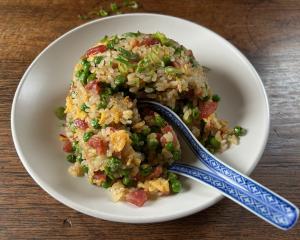
I made a batch of herb and potato cakes this week, each a tangle of coarsely grated spring onion and potato, and the size of a dinner plate. As the latticework rounds crisped in the pan, I grated a fistful of cheese over the top to melt into the crust, and scattered the surface with young thyme, parsley and sage leaves. I’m not sure what I would call these cakes, or even if it matters. They could go by the name of galette or rosti, potato pancake or fritter. They were only a very short jump from a latke.
What matters is that they were delicious. The potatoes, waxy and yellow-fleshed, were rubbed on the coarse side of a box grater, left to drain, then squeezed and tossed with nigella seeds and just enough egg and flour to hold the strands together. Once you get used to it, turning the cake in the pan is easy enough with the help of a fish slice.
I also made a rather lovely cream for summer fruits, scented with vanilla and as thick as cheesecake. I leave yoghurt and mascarpone in a white cloth to drain to eat with dried apricots poached in a chartreuse mint-leaf syrup.
The potato cake and the mint syrup are little celebrations of the young herb leaves around in spring and early summer, those whose flavour is mild and whose texture is fragile. Later in the year, with time spent in the sun, those flavours will be more strident, the leaves of thyme and marjoram too coarse to eat raw.
The herbs I grow are all in pots. There would usually be more in my garden than I have now but the local nurseries are stripped bare — making those I do have all the more precious.
As you scatter the herbs over the hot, melting cheese and crisp potato, their fragrance wafts up. Use whichever you have that work with cheese. I suggest thyme and its pink flowers, or chives, basil, young sage leaves and tarragon. Use chervil or sweet cicely if you grow it.
Potato cake, fontina and herbs
Serves 2-3
650g waxy, yellow-fleshed potatoes
4 thin spring onions
2 Tbsp plain flour
2 tsp nigella seeds
1 egg, beaten
2 Tbsp groundnut or vegetable oil
100g fontina*
25g herbs
Method
Scrub the potatoes, or peel if you wish, then grate coarsely in long, thin shreds. I use the coarse grater of a food processor. Put the grated potatoes in a sieve over a bowl and let them drain for 20 minutes.
Trim the spring onions, discarding only the roots and tough ends of the shoots, then slice them finely. Season with salt and black pepper, then stir into a bowl with the drained potatoes and the flour, nigella seeds and beaten egg.
Warm the oil in a 22-25cm nonstick frying pan, keeping the heat no more than moderately high. Place the potato mix in the pan, spreading it to fill the base. Don’t be tempted to smooth it flat — the cake is lighter if it isn’t compacted.
Let the potato cake cook for 8-10 minutes, regulating the temperature when necessary until the base is crisp and golden. Check its progress by lifting up the edge with a palette knife or slotted slice. Carefully turn the cake over either by lifting with a large metal slice or palette knife, or by placing a plate over the top of the pan and, holding it tightly in place, carefully flipping the pan over, then slide the cake back into the pan.
Leave to brown lightly on the underside. Finely grate the cheese over the top of the potato cake leaving a rim around the edge. Place a lid over the pan, remove from the heat and leave for 5 minutes for the cheese to melt.
Chop the herb leaves and scatter over the cake. Cut into slices and serve.
*Gruyere or gouda are perfectly fine substitutes for fontina.
Apricots in mint syrup with mascarpone cream
Serves 4
90g caster sugar
500ml water
50g mint
200g dried apricots or 12 fresh apricots
For the mascarpone cream
150g thick yoghurt
150g mascarpone
145g white caster sugar
125ml cream
1 few drops of vanilla extract
To finish
15g caster sugar
10 mint leaves
Method
To make the cream
Put the yoghurt in the bowl of a food mixer. Add the mascarpone and caster sugar and beat for a minute or two until well combined. Mix in the cream, then a drop or two of vanilla extract.
Line a deep, fine sieve with muslin or similar clean cloth, leaving some of it to overhang. Transfer the vanilla cream mixture into it. Smooth the surface then gather the overhanging cloth together and twist tightly. Place the sieve over a bowl to catch any drips then refrigerate for at least 6 hours. During its time in the fridge the cream will firm and thicken.
For the apricots
Put the sugar in a small pan, add the water and bring to the boil. Remove the mint leaves from their stems, finely chop and add to the syrup.
Add the apricots, lower the heat and leave to simmer till the fruit is tender.
The exact time will depend on whether you are using dried fruit (about 10 minutes) or fresh (8-20 depending on their ripeness).
Leave the fruit to cool in its syrup.
Using a mortar and pestle, pound the extra mint leaves and sugar to a green paste, then sprinkle over the apricots as you serve.
— Guardian News and Media











